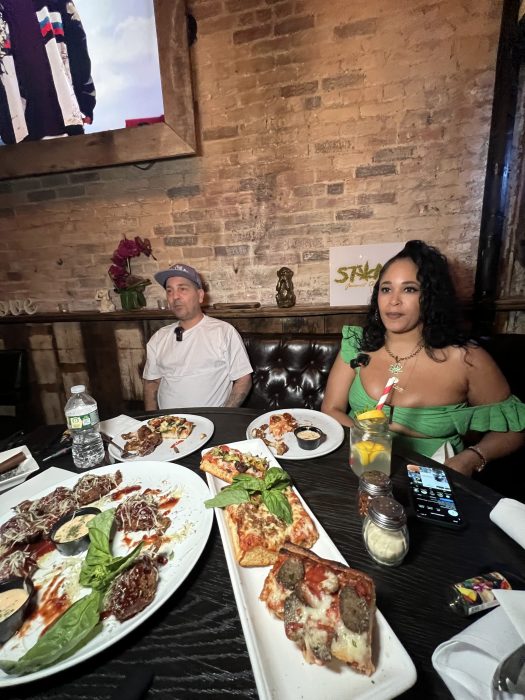By Chris Fuchs
This is no small feat, mind you. How does one even begin to reconcile the hip-hop culture with the motif of Martha Stewart?
“I think the combination of what me and Toni do is cool because, at first, we were like, 'How's it gonna be, like I got the urban kinda thing goin' on and you got the country kinda style,” said Kirkos's partner, Louie Gasparro, in heavy Brooklyn-ese. (Note: Gasparro is not from Brooklyn.) “But you know what I think makes it? It's all colorful and it all comes together like a colorful thing.”
Tonimarie Kirkos and Louie Gasparro, friends since they were kids, have spent the latter part of their lives doing their own things, colorful things. While Kirkos, an accountant for a public access cable station, was dabbling in dance school and interior design, Gasparro was jumping from band to band. First it was heavy metal, then rock, then bossa nova, then punk, and now hip-hop. He plays with the band “The Lords of Brooklyn.”
Neither Kirkos nor Gasparro had had any formal art training. They knew each other from the old neighborhood, Astoria, and took classes together at Long Island City HS.
“She had a crush on me, and I was really snotty to her – according to her,” Gasparro said. That last comment drew a snide look from Kirkos.
After graduating in 1984, though, the two went their separate ways. It wasn't until almost a decade later that Kirkos and Gasparro, having discovered that they were living only blocks away from each other in Whitestone, got back together and conceived of a boutique that would bring “country stuff,” as Gasparro terms it, and graffiti art under the same roof.
On July 22, The Mint became that realization. The most cursory glance at this SoHo-styled boutique reveals immediate diametric differences in artistic taste. Kirkos: wicker baskets, country pottery, bath oils and scented soaps. Gasparro: graffiti, graffiti, graffiti, graffiti. And considering the negative connotations that leech onto the word “graffiti,” Gasparro knows he has a hair's-breadth line to toe.
“It's art, regardless of what you think about it,” Gasparro said. “If somebody's gonna go and write on your garage, some scribble, then that's vandalism. Even if I did a beautiful piece on your house and you didn't want it there, I'm vandalizing your house.”
So what does Gasparro scrawl graffiti on? A denim jacket, for instance, that prominently hangs in the back of his store. A canvas. A T-shirt. Even a scaled-down model of a subway or bus. Anything, really.
About the subways and buses: Way back when, before the credo “let's cleanup New York” was modish, Gasparro and his muse were busy with subway cars. As a graffiti writer, between 1977 and 1982, the paragon of artistry was to create a sort of subway graffiti wrap, called a top-to-bottom whole car. This would sometimes take upwards of eight hours, depending on the degree of intricacy sought.
But then Mayor Koch launched an all-out offensive on graffiti writers. He planted watchdogs in train yards, coated subway cars with a chemical that dissolved the spray paint, Gasparro said.
So, grasping for a sense of nostalgia, Gasparro has turned to his model subway cars and buses on which he scrawls graffiti. They are fast selling items indeed, a throwback to a bygone era, that he says everyone has been exposed to, firsthand or otherwise. As for the graffiti, he'll write anything you want.
Louie Gasparro's foil, Tonimarie Kirkos, is not a graffiti writer. She isn't square, either. Most of her work looks like that which you would find in a New England arts-and-crafts shop. And still, it exudes a quirky, contemplative I-will-break-the-mold character, kind of like her personality.
Take the bland-looking, wooden snack table, for instance, propped up near the front counter in the store. At first blush, when it still has a few trifles resting on its surface, it looks ordinary. But a second glance, once those items are removed, reveals a sedate psychedelic color scheme, blotches of purple and blue paired up with other colors that traditionally do not match.
“I don't like the comment, 'Well, if people say black and white match or blue and white…' ” she said. “I like all different colors together. That's the challenge.”
The tables are about as far to the margins as Kirkos is willing to go. Not surprisingly, Kirkos thus tends to attract an older crowd, whereas Gasparro is a magnet for hip-hop teenagers, a culture emblematic of contemporary African-American urban youth, including break dancing, rap music and graffiti art. Occasionally, though, there is some crossover.
“Whitestone doesn't have anything like this,” Gasparro said. “Everybody is buying something of everything we do. People you wouldn't think would be into graffiti art, like older people, are like, 'I want that on a canvas.' “
Kirkos has had the same experience with Gasparro's following. “A young gentleman came in one day and wanted to get something for his grandma,” Kirkos said. “So I took a lot of things like soaps and lotion, and I painted a tulip and wrote, 'Happy Birthday Grandma with All My Love.” I like to take a lot of time, because that's the way I am with my family and close friends.”
So, then, what does The Mint at 14-03 150th St. have to do with any of this? “The Mint?” Gasparro said, seeming surprised by the question. “Ya know, it's a Queens expression. If something is 'mint,' it's cool.”































